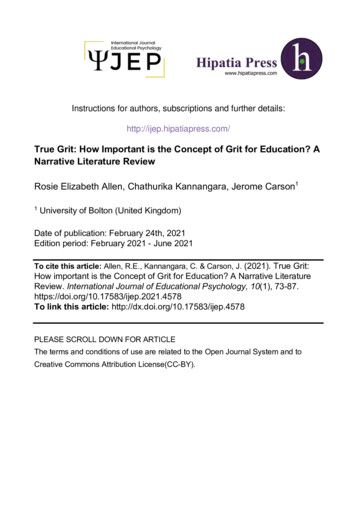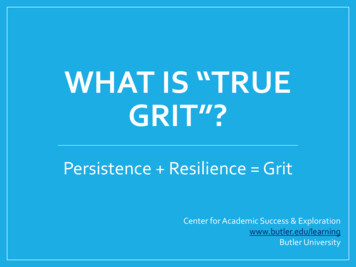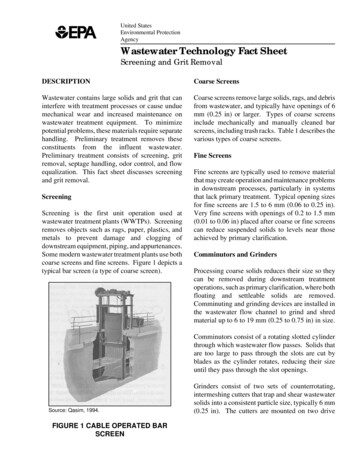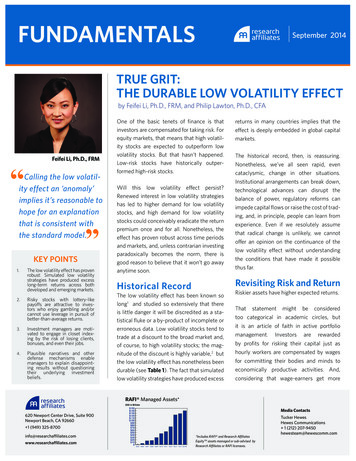
Transcription
Instructions for authors, subscriptions and further details:http://ijep.hipatiapress.com/True Grit: How Important is the Concept of Grit for Education? ANarrative Literature ReviewRosie Elizabeth Allen, Chathurika Kannangara, Jerome Carson11University of Bolton (United Kingdom)Date of publication: February 24th, 2021Edition period: February 2021 - June 2021To cite this article: Allen, R.E., Kannangara, C. & Carson, J. (2021). True Grit:How important is the Concept of Grit for Education? A Narrative LiteratureReview. International Journal of Educational Psychology, 10(1), 73-87.https://doi.org/10.17583/ijep.2021.4578To link this article: http://dx.doi.org/10.17583/ijep.4578PLEASE SCROLL DOWN FOR ARTICLEThe terms and conditions of use are related to the Open Journal System and toCreative Commons Attribution License(CC-BY).
IJEP – International Journal of Educational Psychology Vol. 10 No.1February 2021 pp. 73-87True Grit: How Important is theConcept of Grit for Education? ANarrative Literature ReviewRosie Elizabeth Allen, Chathurika Kannangara, Jerome Carson1University of Bolton (United Kingdom)AbstractAn abundance of literature exists that explores the potential applications of grit inpredicting several academic outcomes. Regardless, the concept of grit has beenheavily criticised due to the number of inconsistencies among current research. Fullyunderstanding the usefulness of grit in an educational context is a worthwhile pursuitand could yield incredibly influential implications. The current narrative reviewaimed to address and explore these inconsistencies to determine the true impact of griton the academic outcomes of school students. Such that, it aimed to establish whethergrit was useful in improving outcomes such as academic achievement, attendance andretention. Research posits that grit is a strong predictor of academic outcomes formany, but not all, students. Furthermore, it seems that the predictive abilities of gritcan be enhanced by concentrating on the perseverance of efforts component of grit,rather than overall grit. While the importance of grit’s perseverance component hasbeen confirmed; there are several recommendations for future research. Likewise, anumber of inconsistencies are discussed relating to grits practical applications withinan educational context. Cultivating grittiness, specifically perseverance of efforts, instudent populations would reap huge rewards. Indeed, the educational rewards forstudents would be substantial, as well as the financial benefits for schools andeducating institutions. The usefulness of cultivating a perseverance of efforts instudents is discussed.Keywords: academic achievement; grit; education; retention; success.2021 HipatiaPressISSN:2014-3591DOI: 10.17583/ijep.2021.4578
IJEP – International Journal of Educational Psychology Vol. 10 No.1February 2021 pp. 73-87La Verdadera Determinación: ¿QuéImportancia Tiene el ConceptoDeterminación Para la Educación? UnaRevisión Narrativa de la LiteraturaRosie Elizabeth Allen, Chathurika Kannangara, Jerome Carson1University of Bolton (United Kingdom)ResumenExiste una gran cantidad de literatura que explora las aplicaciones potenciales de ladeterminación en la predicción de varios resultados académicos. Sin embargo, elconcepto de determinación ha sido muy criticado debido a la cantidad deinconsistencias entre las investigaciones recientes. La presente revisión de literaturaaboda y explora estas inconsistencias para determinar el verdadero impacto de ladeterminación en los resultados académicos de los estudiantes. De este modo, sepretende establecer si la determinación es útil para mejorar resultados como elrendimiento académico, la asistencia y la permanencia. La investigación postula quela determinación es un fuerte predictor de los resultados académicos para muchosestudiantes, aunque no para todos. Además, parece que la capacidad de predicción deleste puede mejorarse concentrándose en el componente de perseverancia de losesfuerzos, en lugar de en el general. Aunque se ha confirmado la importancia delcomponente de perseverancia, son varias las recomendaciones para futurasinvestigaciones. Asimismo, se discuten varias incoherencias relacionadas con lasaplicaciones prácticas de la determinación en el contexto educativo. Cultivar latenacidad del alumnado, concretamente la perseverancia en los esfuerzos, supondríaun gran beneficio. Las recompensas educativas para los estudiantes seríansustanciales, así como los beneficios financieros para las escuelas y las institucioneseducativas. Se discute la utilidad de cultivar la perseverancia de los esfuerzos en losestudiantes.Palabras clave: rendimiento académico; determinación; educación; retención;éxito.2021 HipatiaPressISSN: 2014-3591DOI: 10.17583/ijep.2021.4578
IJEP – International Journal of Educational Psychology, 10(1)75It was originally believed that intelligence was of crucial importancein determining which students will be successful at school and whichwill not (Allen & Bond, 2001; Kidd & Latif, 2003). It was not untilthe 1970’s when psychologists were challenging this idea and found thatacademic achievement goes above and beyond IQ (Poropat, 2009).Henceforth, researchers identified that certain qualities and characteristics,such as grit, equate to greater academic achievement. Initially articulated byAngela Duckworth in 2007, the concept of grit has exploded in terms ofattracting the attention of psychology researchers across the globe(Duckworth, Peterson, Matthews & Kelly, 2007; Duckworth, 2016). Definedas expressing a passion and perseverance for pursuing long-term goals, gritprovides individuals with the ability to strive towards achieving their longterm goals while persisting in the face of adversity (Duckworth, 2016).Subsequently, researchers began to investigate the potential applications ofgrit, including the potential usefulness of grit in predicting academic outcomessuch as engagement, motivation, performance and achievement. As a result,grit was exposed as a characteristic that is strongly associated with academicoutcomes. For instance, students who express a passion towards theirschoolwork and persevere with their studies despite of academic and socialchallenges are most likely to experience academic success. Regardless, grithas been heavily criticized by many researchers and inconsistencies amongcurrent research need to be addressed and explored.MethodThis narrative literature review aims to provide up-to-date knowledge aboutthe concept of grit and its importance in education. As there was nopredetermined research question, no specific search strategy or criteria wereapplied. This narrative literature review was conducted over a period ofseveral years and contributed towards the authors continued grit research inhigher education. Over a period of time, literature was collected, includingempirical and commentary papers, which played an important role incontinuing education, feeding into the development of an academic tenacitymeasure and furthering grit research in higher education.The Relationship between Grit and Academic OutcomesSince 2007, when Angela Duckworth pioneered research into the concept ofgrit, an abundance of researchers around the world have begun to explore its
76 Allen et al.,- Concept of grit for educationpotential within education. After decades of research, it became clear thatthere were many inconsistencies among findings. Indeed, some researchhighlighted the usefulness of measuring and monitoring grittiness in studentswhen predicting academic outcomes (Duckworth et al., 2007; Datu, Yuen &Chen, 2018; Cross, 2013); while other studies have presented evidence tosuggest that it is of no significant importance to students (Bazelais, Lemay &Doleck, 2016; Palisoc, Matsumoto, Ho, Perry, Tang & Ip, 2017; Dixson,Robertson & Worrell, 2017). Much research demands the crucial importanceof grit in determining which students will excel in their academic studies andwhich students will struggle. Moreover, it has been documented that grittierstudents are increasingly likely to be engaged in their academic studies (Datuet al., 2018) and are subsequently increasingly likely to experience academicachievement as a result (Lee & Sohn, 2017; Cross, 2013). That is, studentswho reported achieving a “D” or “F” in their exams possessed a reduced levelof grit (Pate, Payakachat, Harrell, Pate, Caldwell & Franks, 2017). Grittierstudents were also shown to spend more time studying (Cross, 2013).Therefore, students with high levels of grit are more likely to exert effort andtime into their studies which will, in turn, have a great impact on theireducational success. Also, gritty students are more likely to express a highersense of self-efficacy. That is, their perseverance of efforts to continue in thepursuit of their academic goals resulted in a heightened belief in their ownacademic abilities – which too, will increases their chances of achievement(Oriol, Miranda, Oyanedel & Torres, 2017).Nonetheless, research has surfaced that does not advocate the significanceof grittiness in school students. Such that, grit was not found to be a significantpredictor of academic achievement or course success; rather it was prioracademic performance that best predicted academic achievement (Bazelais etal., 2016). These findings were supported by a group of researchers that alsofound no significant relationship between grit and academic success (Palisocet al.,2017). This study concentrated on students in America and can thereforeonly be generalized to similar students from a similar institution. The researchthat denies the significant impact of grit on academic achievement imply thatscreening for grit is not sufficient in attaining useful information aboutstudent’s success.
IJEP – International Journal of Educational Psychology, 10(1)77Is Grit an Important Characteristic for All Students?Furthermore, research has posited that grit is not a culturally diverse trait andthat it is not a beneficial trait for all students. Such that, grit was reported tobe a poor predictor of academic achievement for African-American students(Dixson et al., 2017). Thus, programs and interventions that are designed toincrease the grittiness of African-American students may not be useful in theattempt to raise their grades. However, it is difficult to generalize thesefindings as this study was conducted in one institution with a small sample ofAfrican-American students. Rather than cultivating grittiness, it could beworthwhile to ensure the students have a sense of belonging and reducedfeelings of isolation. Perhaps there are more relevant and suitablepsychological traits that should be of focus when uplifting the academicachievement of African-American students, but this needs to be furtherexplored. While grit does not seem to be influential for African-Americanstudents, it has proved effective in Mexican-American adolescents. Indeed,academic achievement was positively predicted by grit in a sample ofMexican-American students (Piña-Watson, Lopez, Ojeda & Rodriguez,2015). Evidently, culture is clearly an important factor to consider whendetermining what the most effective and suitable interventions are to enhanceacademic outcomes in students of varying backgrounds. Little research hasdirectly investigated the usefulness of grit in different cultures. Furthermore,cross-cultural literature into grit has revealed that Asian and Asian-Americancultures are more likely to exert effort into academic tasks and present taskpersistence compared to Americans (Hsin & Xie, 2013; Jose & Bellamy,2012). In contradiction to this, one study found that students from NewZealand declared higher levels of the perseverance of effort component of gritthan students from Thailand (Raphiphatthana, Jose & Chobthamkit, 2018).However, Asian cultures are known to be influenced by social norms such asself-criticism (Eaton & Dembo, 1997) which could result in Thai studentsunder-representing their hard work and determination and ultimately impacton their self-reported grit scores. As little research has been carried out thatexplores cultural differences in grittiness, it is difficult to draw solidconclusions. Therefore, more research needs to investigate the culturalsensitivity of grit as a construct. Perhaps an adapted version of the grit scale,or even a new scale should be developed – that considers cultural values andexperiences. This would help multicultural schools to apply grit interventions
78 Allen et al.,- Concept of grit for education- if necessary and suitable - to their students, as well as aid schools all aroundthe world.The Importance of Grit on the Retention of School StudentsThe retention and dropout rates of students have long been a concern foreducating institutions and organizations all over the world (Brown, 2012).Consequently, early research into grit demonstrated that levels of grit couldgreatly predict the retention of military cadets in an extensive trainingprogram (Duckworth, 2007; Eskreis-Winkler, Shulman, Beal & Duckworth,2014; Maddi, Matthews, Kelly, Villarreal & White, 2012). In addition, it hasalso been proposed that grit is a major contributing factor towards theeffectiveness and retention of novice teachers in challenging educationenvironments (Robertson-Kraft & Duckworth, 2014; Duckworth & Quinn,2009). More recent research has also suggested that grit can greatly impactthe retention of students in schools, colleges and universities (Bazelais et al2016; Eskreiss-Winkler et al., 2014). Moreover, research presented that theidentification and awareness of long-term goals and the early identification oftheir course of interest are imperative to student retention (Hagedorn,Maxwell & Hampton, 2001). More specifically, primary and high schoolstudents with enhanced levels of grit were increasingly likely to graduate fromhigh school and with higher rates of attendance (Saunders-Scott, Braley &Stennes-Spidahl, 2017). As grit predicts retention in school students aboveand beyond characteristics such as cognitive ability and grades, it could proveto be crucial in schools. For instance, student attendance and retention tend tobe a common issue among high schools and measuring and monitoring gritwill provide educators with the opportunity to direct at-risk students to supportservices. Therefore, interventions that are designed to increase students levelof grit will ultimately improve attendance and retention.Is Grit the Best Possible Predictor of Academic Outcomes?Evidence has consistently presented grit as being highly correlated with otherachievement-related characteristics. Moreover, findings have surfaced thathighlight the considerable overlap between grit and other constructs. Researchhas posited that the grit scale is fundamentally measuring the same trait as thatof the Big Five’s conscientiousness (Rimfeld, Kovas, Dale & Plomin, 2016).Moreover, the intercorrelation between overall grit and conscientious issignificantly higher than what is typical between two constructs (Pace &
IJEP – International Journal of Educational Psychology, 10(1)79Brannick, 2010). Consequently, it has been argued that grit has succumb tothe jangle fallacy, which states that grit is simply a reconstruction of theconcept of conscientiousness (Crede et al., 2016). Research found thatconscientiousness predicted about 6% of variance in GCSE grades, while gritadded little or no variance in scores. This suggests that, ultimately, grit andBig Fives conscientiousness are fundamentally the same trait (Rimfeld et al.,2016). Other research supports this notion by revealing that after controllingfor other Big Five traits, it was found that academic outcomes weresignificantly predicted by conscientiousness and emotion regulation ability;but not grit (Ivcevic & Brackett, 2014). These findings argue for theimportance of traits such as conscientiousness and self-regulation indetermining the educational success of students; rather than focusing on grit.Nonetheless, it has been identified that two constructs can be intenselycorrelated with each other, but still manifest different relations with a furthervariable (McCornack, 1956). For instance, while grit and conscientiousnessare heavily related, they hold differing predictive abilities in an educationalcontext. Indeed, some research has found that grit is a construct that is distinctfrom any other. Indeed, grit was a predictor of career preparation behavioreven when personality traits such as conscientiousness were controlled for(Lee & Sohn, 2017). However, overall grit regularly lacks in terms ofpredicting academic achievement as compared to other constructs.While overall grit only moderately correlates with academic performance;characteristics such as cognitive ability (Sackett et al., 2012), study habits andskills (Crede & Kuncel, 2008) and academic adjustment (Crede & Neihorster,2012) have reported a correlation that is nearly twice as strong. Regardless,considering variables that have small and moderate effects on academicoutcomes could have huge implications for educating institutions around theworld. Furthermore, the ability to predict the academic outcomes of a studentpopulation could yield huge benefits. Even minor improvements on students’academic achievement and the school’s ability to retain students could meanuseful and positive effects – not only on the students but the institution itself.For instance, boosting the academic achievement of school students by onlyone or two percent could result in higher grades for hundreds, if not thousands,of students (Crede et al., 2016). Similarly, increasing the retention rate ofstudents in any school could have great financial benefits for the school(Hunter & Hunter, 1984). Nevertheless, perseverance of efforts – as opposed
80 Allen et al.,- Concept of grit for educationto overall grit - explained greater variance in academic achievement over andabove conscientiousness and other seemingly related constructs (Pace &Brannick, 2010). It could be worthwhile to focus on the perseverancecomponent of grit as opposed to overall grit, as research advocates the strongrelation between perseverance and academic outcomes.A Perseverance of Efforts and a Consistency in InterestsThe construct validity of grit is in question as current evidence does notsuggest that grit is a higher-order construct that is comprised of two lowerorder facets (Crede et al., 2016). Indeed, it has been revealed that the measureof grit is comprised of two separate facets, a perseverance of efforts and aconsistency of interests. Furthermore, it has been exposed that these twocomponents of grit have different predictive abilities in terms of academicoutcomes in schools. For instance, one piece of research has reported thatalthough gritty students attained higher academic grades, further breaking theconstruct down into two parts has better benefits. Such that, a consistency ofinterests accounted for 3% of variance in student’s academic achievement;while the perseverance of efforts component explained 9% of variance inscores (Mason, 2018). This suggests that the perseverance of effortscomponent of grit is more appropriate when determining which students willachieve higher academic marks, while the consistency of interests componentis less useful (Mason, 2018). Some research supports these findings andsimilarly presented that grit, as an overall construct, was only moderatelyassociated with academic achievement; while the perseverance of efforts is astrong predictor and consistency of interests was not (Wolters & Hussain,2015; Weisskirch, 2016). Moreover, grit’s perseverance of efforts was seen topredict all indicators of self-regulated learning including self-efficacy andprocrastination; while the consistency of interests facet did not (Wolters &Hussain, 2015). Again, grit did not predict achieved final grade, butperseverance of efforts predicted estimated grade (Weisskirch, 2016).Evidently, combining the two sub-components of grit into one overall gritscore seems to significantly reduce its ability to predict academic outcomessuch as achievement and performance (Crede et al., 2016). It has consistentlybeen demonstrated that the perseverance of efforts component of grit is amuch better predictor of academic achievement than the consistency ofinterest component, as well as overall grit. Therefore, to optimize the potentialof the grit scale in predicting academic achievement in school children,
IJEP – International Journal of Educational Psychology, 10(1)81educators should focus on the perseverance of efforts facet (Crede et al.,2016).Harvesting a Successful Student PopulationEducating institutions and organisations all over the world have demonstratedthe influential effects of selected interventions on academic performance andachievement. Whether enhancing the grit levels of students is possible has notyet been ascertained. However, interventions that concentrate on elevating anindividual’s resilience and social and personal skills have proved to beeffective (Durlak et al., 2010; Paunesku et al., 2015). Thus, it seems possibleto suggest that grit interventions could also have a positive effect on academicoutcomes. For instance, some research has shown that outcomes related toeducational success can be uplifted by cultivating traits that are seeminglyrelated to grit. Such that, by helping students to feel that they “fit in” and thatthey belong to the student population and have value within the university,academic achievement was increased (Walton & Cohen, 2011). Additionally,offering students insight into how their course is relevant to their own lives,and aligning their interests with their own life increased academicachievement (Hulleman & Harackiwcz, 2009). Setting goals, identifyingpossible obstacles and challenges to their studies and helping students learnself-control strategies can increase academic performance, increaseengagement and reduce absences (Oyserman, Bybee & Terry, 2006; Brigman& Webb, 2007). Finally, the use of a self-efficacy based intervention wasinvestigated among university students and it was revealed that a 4-monthindividual cognitive-behavioural intervention program increased selfefficacy, engagement, performance and retention (Bresó, Schaufeli &Salanova, 2010) – which, in turn, would optimise academic outcomes. All ofthe above traits and characteristics have been closely associated with grittinessin students, and each have shown great success in uplifting the educationalsuccess of students.It is therefore a worthwhile pursuit of educating institutions throughout theUK to consider interventions that could potentially enhance the perseveranceof their students as previous research has revealed that interventions toincrease similar traits are greatly effective. As a result, it is crucial toacknowledge the perseverance of the student population in order to monitorand regulate the achievement of students. Furthermore, these already existinginterventions and programs can be improved upon and developed through the
82 Allen et al.,- Concept of grit for educationinclusion of grit’s perseverance of efforts component. By embedding this - asa factor that enhances academic outcomes such as achievement, engagementand motivation - students will benefit from a program that is designed tooptimize their full potential and as a result, experience greater academicachievement and success.ConclusionGrit is a strong predictor of academic outcomes for many students – but notall students. Consequently, the cultural-sensitivity of grit is in question andneeds to be addressed. Regardless, research has posited that grit is ameaningful concept that has predictive abilities within education. In fact, theimpact of grit on academic outcomes can be further enhanced byconcentrating on the perseverance of efforts component of grit rather thanoverall grit. Grit has been heavily criticized for falling victim to the janglefallacy, which states that grit is simply a reconstruction of the construct ofconscientiousness. However, the perseverance component has reported topredict academic outcomes over and above those of conscientiousness. It cantherefore be suggested that measuring and monitoring student’s perseveranceof efforts is a highly effective method in determining which students willsucceed and which students can be directed to support. Furthermore, thecultivation of grittiness as a trait has not yet been proved possible; butenhancing seemingly-related traits has been beneficial to academicachievement. Thus, it can be concluded that enhancing grit – namelyperseverance of efforts - can have a great impact on academic achievement,attendance and retention. As a result, the educational rewards for studentswould be substantial, as well as the financial benefits for schools andeducating institutions. With this in mind, focusing on grittiness orperseverance of student populations alone would be simplistic and limits thepotential of student’s success. Such that, a recently developed modeladvocates that a successful or thriving student should express determinationtowards goals, be focused on their strengths, persist in the face of adversity,embrace challenges and notice the responsibility they hold over their ownchoices and actions (Kannangara, 2015). To optimize the full potential ofstudents, the incorporation of grit alongside other achievement-relatedcharacteristics such as self-control, resilience and well-being is essential. So,
IJEP – International Journal of Educational Psychology, 10(1)83while grit is of incredible usefulness in an educational context, other traitsshould not be ignored.ReferencesAllen, D. D., & Bond, C. A. (2001). Prepharmacy predictors of success inpharmacy school: grade point averages, pharmacy college admissionstest, communication abilities, and critical thinkingskills. Pharmacotherapy, 21(7), 566Bazelais, P., Lemay, D. J., & Doleck, T. (2016). How Does Grit ImpactCollege Students' Academic Achievement in Science?. European Journalof Science and Mathematics Education, 4(1), 33-43.Bresó, E., Schaufeli, W. B., & Salanova, M. (2011). Can a self-efficacybased intervention decrease burnout, increase engagement, and enhanceperformance? A quasi-experimental study. Higher Education, 61(4), 339355. , G., & Webb, L. (2007). Student success skills: Impactingachievement through large and small group work. Group Dynamics:Theory, Research, and Practice, 11(4), n, J. (2012). Developing a freshman orientation survey to improvestudent retention within a college. College Student Journal, 46(4), 834851.Credé, M., & Kuncel, N. R. (2008). Study habits, skills, and attitudes: Thethird pillar supporting collegiate academic performance. Perspectives onpsychological science, 3(6), 425-453. dé, M., & Niehorster, S. (2012). Adjustment to college as measured bythe student adaptation to college questionnaire: A quantitative review ofits structure and relationships with correlates andconsequences. Educational Psychology Review, 24(1), 133-165.Credé, M., Tynan, M. C., & Harms, P. D. (2017). Much ado about grit: Ameta-analytic synthesis of the grit literature. Journal of Personality andsocial Psychology, 113(3), 492. https://doi.org/10.1037/pspp0000102Cross, T. M. (2013). Staying the course: Grit, academic success, and nontraditional doctoral students.Datu, J. A. D., Yuen, M., & Chen, G. (2018). The triarchic model of grit islinked to academic success and well-being among Filipino high school
84 Allen et al.,- Concept of grit for educationstudents. School Psychology Quarterly, 33(3), 428.https://doi.org/10.1037/spq0000234Dixson, D. D., Roberson, C. C., & Worrell, F. C. (2017). Psychosocial keysto African American achievement? Examining the relationship betweenachievement and psychosocial variables in high achieving AfricanAmericans. Journal of Advanced Academics, 28(2), ckworth, A. L., Peterson, C., Matthews, M. D., & Kelly, D. R. (2007).Grit: perseverance and passion for long-term goals. Journal ofpersonality and social psychology, 92(6), ckworth, A. L., & Quinn, P. D. (2009). Development and validation ofthe Short Grit Scale (GRIT–S). Journal of personality assessment, 91(2),166-174. , A. (2016). Grit: the power of passion and perseverance.London: Vermilion.Durlak, J. A., Weissberg, R. P., Dymnicki, A. B., Taylor, R. D., &Schellinger, K. B. (2011). The impact of enhancing students' social andemotional learning: a meta-analysis of school-based universalinterventions. Child development, 82(1), .01564.xEaton, M. J., & Dembo, M. H. (1997). Differences in the motivationalbeliefs of Asian American and non-Asian students. Journal ofEducational Psychology, 89(3), 433. inkler, L., Duckworth, A. L., Shulman, E. P., & Beal, S. (2014).The grit effect: Predicting retention in the military, the workplace, schooland marriage. Frontiers in psychology, 5, n, L. S., Maxwell, W., & Hampton, P. (2001). Correlates ofretention for African-American males in community colleges. Journal ofCollege Student Retention: Research, Theory & Practice, 3(3), LHsin, A., & Xie, Y. (2014). Explaining Asian Americans’ academicadvantage over whites. Proceedings of the National Academy ofSciences, 111(23), 8416-8421. https://doi.org/10.1073/pnas.1406402111Hulleman, C. S., & Harackiewicz, J. M. (2009). Promoting interest andperformance in high school science classes. Science, 326(59
understanding the usefulness of grit in an educational context is a worthwhile pursuit and could yield incredibly influential implications. The current narrative review aimed to address and explore these inconsistencies to determine the true impact of grit on the academic outcomes of school students. Such that, it aimed to establish whether










